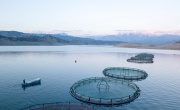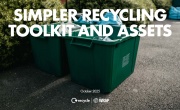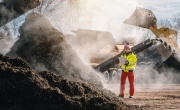Recycling overtakes landfilling in England
Official figures released today (8 November) by the Department for the Environment, Food and Rural Affairs (Defra), show that for the first time since records began, English local authorities recycled, composted or reused more than they landfilled.
From the year April 2011 to March 2012, around 10.7 million tonnes of household waste was recycled, composted or reused, against the 9.6 million tonnes of waste that was landfilled. This has been partly attributed to the rise in authorities choosing to incinerate residual waste.
The figures go on to outline that in 2011/12, 43 per cent of household waste was recycled, the highest ever recycling rate recorded for England. However, the year saw the lowest year-on-year increase in a decade, with 2011/12 rates increasing by 1.5 per cent on the year before.
Defra says that this could indicate that authorities ‘have by now exploited the easiest targets in terms of recycling, and are increasingly facing challenges in influencing behaviour change and identifying new areas and efficiencies in the waste services they provide’.

Waste generation was also continuing a positive trend, with 22.9 million tonnes of household waste (431kg of waste per person) generated last year, continuing the downward trend since 2007/8.
Defra’s Minister for Resources, Lord de Mauley said: “Across the country, people are cutting the amount of waste going to landfill by recycling more. They are not only protecting the environment, but fuelling a growing industry that reuses the things they throw away.
“More still needs to be done and we continue to push towards our aim of a zero waste economy, with businesses, councils and householders all doing their bit.”
Though these figures demonstrate a positive step towards improving recycling in England, the numbers are still markedly behind Wales, whose soon-to-be-released statistics are expected to show municipal waste recycling rates as being over 50 per cent.

According to the data submitted by local authorities, The Vale of White Horse District Council had the highest recycling rate of 68.7 per cent for the year April 2011 to March 2012. These figures were almost matched by those reported by neighbouring South Oxfordshire District Council, which saw a 67.9 per cent rate. This rise has been attributed to the fact that the council rolled out its new recycling service in October 2010, after seeing a recycling rate of just over 36 per cent.
Rochford District Council, which topped the league last year, came in third, with 67.4 per cent of waste recycled.
For the top two councils, shifting collection of residual waste to alternate weekly collections has proved key to the success, augmented by a comprehensive recycling service capturing a wide range of materials. Both have also recently started a kerbside collection of batteries and have seen waste electrical banks for small items such as kettles and toasters installed in the main towns across both districts.
Matt Prosser, Strategic Director for both councils, said that they introduced the new service as a response to residents wanting to recycle more. He commented: “Above all, we kept [the service] simple so that residents could recycle as much as possible in the easiest possible way.”
Ashford Borough Council in Kent came out bottom of the league, with a recycling rate of 14 per cent, just up from Lewisham’s rate of 17.2 per cent.
Runnymede Borough Council in Surrey was the most improved council in 2011/12, seeing its rates increase from 29 per cent in 2010/11 to 47 per cent in 2011/12.
A full run down of the league table figures, along with a league table based on residual arisings per capita, will be published in the Jan/Feb issue of Resource.
Read the final figures for England's local authority recycling rates.







